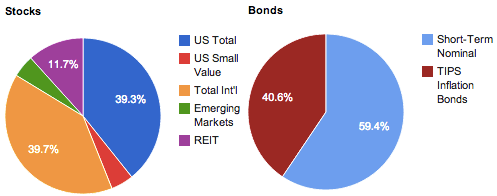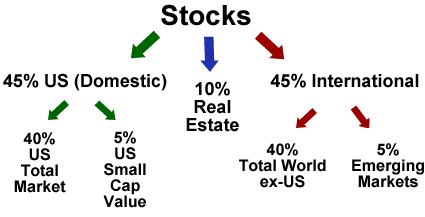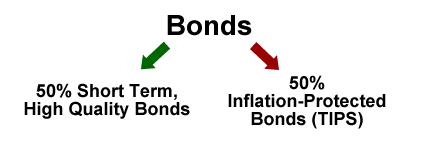Here’s a belated 2012 year-end update of our investment portfolio, including employer 401(k) plans, self-employed retirement plans, Traditional and Roth IRAs, and taxable brokerage holdings. Cash reserves (emergency fund), college savings accounts, experimental portfolios, and day-to-day cash balances are excluded. This is the portfolio that we are depending on to create income and thus financial freedom.
Asset Allocation & Holdings
Here is my current actual asset allocation:

The overall target asset allocation remains the same:


Put simply, I pick asset classes that are likely to provide a long-term return above inflation, as well as offer some historical tendencies to be less correlated to each other. I don’t hold commodities futures or gold because I am not confident in them enough to know that I will hold them through an extended period of underperformance (and if you don’t do that, there’s no point). Our current ratio is about 75% stocks and 25% bonds.
For the last decade, I have stuck to buy, hold, and rebalance. I also keep costs at a minimum in terms of fund expense ratios, commissions paid, and tax-efficiency. A list of specific holdings is below.
Stock Holdings
Vanguard Total Stock Market Fund (VTI, VTSMX, VTSAX)
Vanguard Small-Cap Value Index Fund (VBR, VISVX, VSIAX)
Vanguard Total International Stock Market Fund (VXUS, VGTSX, VTIAX)
Vanguard Emerging Markets Fund (VWO, VEIEX, VEMAX)
Vanguard REIT Index Fund (VNQ, VGSIX, VGSLX)
Bond Holdings
Vanguard Limited-Term Tax-Exempt Fund (VMLTX, VMLUX)
Vanguard High-Yield Tax-Exempt Fund (VWAHX, VWALX)
PIMCO Total Return Institutional* (PTTRX)
Stable Value Fund* (2.6% yield, net of fees)
iShares Barclays TIPS Bond ETF (TIP)
Individual TIPS securities
The only significant change from last time is that I have moved some money over to the Vanguard High-Yield Tax-Exempt Fund. If you look at the holdings, it’s actually a relatively high-quality, intermediate-term municipal bond fund. Over 80% of the bonds are rated A-AAA, and the duration is only 6 years. Compare this with the popular Vanguard Total Bond Market Index Fund that is 90% A-AAA (tons of US government-backed debt at very low rates), and a duration of 5 years. I like mixing this fund with the Limited-Term muni fund to replace a Total Bond fund for my bonds in taxable accounts as my income tax bracket is high. I admit that I am reaching for yield, but I don’t think I’m reaching very much overall and I’m getting enough incremental yield in return. Inflation-linked bonds and the rest are in tax-deferred accounts.
A future change that I am looking to implement is to swap out Vanguard Small-Cap Value Index Fund for probably the iShares Russell 2000 Value ETF (IWN) as it holds even smaller, more-value oriented stocks than the Vanguard ETF. Also, I want to swap out Vanguard Emerging Markets Fund for the WisdomTree Emerging Mkts SmallCap Dividend ETF (DGS) as if focuses on small, dividend/value-oriented stocks in emerging countries. Why? The whole point of those small 5% allocations is to add some spice and risk to my portfolio while reaching into areas not well-covered by the broad index funds.
The overall expense ratio for this portfolio is in the neighborhood of .20% annually, or 20 basis points, which is much lower hurdle to overcome than the average mutual fund expense ratio of over 1% annually. PTTRX and Stable Value fund are the best of limited choices in a 401k. This is all DIY, so I don’t pay portfolio management or financial advisor fees.
Personal Rate of Return
I usually don’t bother calculating the actual rate of return because doing it properly involves accounting for the dates and amount of all new contributions. In addition, most of my investments are passive so you can find the performance easily by looking at individual index and/or fund returns. But doing some rough calculations for 2012:
Total US +16.4%
Total International +18.2%
US Small Cap Value +18.6%
Emerging Markets +18.8%
REIT +17.7%
Total US Bond +4.0%
TIP +6.8%
————
Weighted average = 14.5%
Early Retirement Progress
To measure our progress towards total financial independence, I use a 3% theoretical withdrawal rate and compare that with our expected future expenses. This is lower than the common 4% withdrawal rate because we intend to retire early and our money may have to last much longer than most (50+ years). This results in a goal of 33 times our expected annual spending. Currently, our portfolio would theoretically cover 66% of our expected expenses.
The 3% withdrawal rate is simply a rule-of-thumb, although I’d like if the dividends and interest payments from our holding would create a 3% yield. Currently, our overall income yield would be somewhere between 2-3%. We may also add a rental property to the mix which would increase yield but also increase potential headache.
 The Best Credit Card Bonus Offers – 2025
The Best Credit Card Bonus Offers – 2025 Big List of Free Stocks from Brokerage Apps
Big List of Free Stocks from Brokerage Apps Best Interest Rates on Cash - 2025
Best Interest Rates on Cash - 2025 Free Credit Scores x 3 + Free Credit Monitoring
Free Credit Scores x 3 + Free Credit Monitoring Best No Fee 0% APR Balance Transfer Offers
Best No Fee 0% APR Balance Transfer Offers Little-Known Cellular Data Plans That Can Save Big Money
Little-Known Cellular Data Plans That Can Save Big Money How To Haggle Your Cable or Direct TV Bill
How To Haggle Your Cable or Direct TV Bill Big List of Free Consumer Data Reports (Credit, Rent, Work)
Big List of Free Consumer Data Reports (Credit, Rent, Work)
Do you plan on keeping TIPS?
Jonathan,
I’m just curious why you don’t use, as an example, a Vanguard Target Retirement fund with the 75/25 ratio you currently have? I’m not suggesting one method is right or wrong, just would like to hear your rationale. Thanks, and keep up the great work on the blog!
You may want to look at the Vanguard Russell 2000 Value ETF – VTWV – in lieu of IWN. Very similiar to IWN with lower expenses, plus free trading if you have a Vanguard account.
@John – Yes, although I may change up the maturities. Man, I should have loaded up when I bought them at 3% real yield at 30-year maturities back in 2009. It’s hard to buy a negative real yield. I’d buy savings I bonds before that, but I already do max those out every year.
@Nuts – First, I like Target funds and have suggested them to both my sister and mom who both hold them. One reason is tax-efficient placement. I get to choose where to put stocks and bonds by buying them separately – can’t do that with a Target all-in-one fund. Another is that I like tweaking and going for yield where I think there is value. Even Jack Bogle himself admitted recently that buying a corporate bond fund would yield more in the long-term right now than US Treasuries or Total Bond. See previous post:
https://www.mymoneyblog.com/whats-inside-the-vanguard-total-bond-index-fund.html
@Preston – Good tip, I’ll definitely look into that. I hope it has good volume. I have a Fidelity account and can get free IWN trades there, although who knows how long that will last.
How often do you rebalance?
@Jonathan – why the small % to Emerging Markets instead of, for instance, Vanguard FTSE Small Cap?
@Sean – I continuously rebalance with new cash inflows, and then I pretty much rebalance when I feel I’m out far out of whack, which actually hasn’t been that often recently as my inflows are still a good % of total portfolio size. I wouldn’t do it more than once or twice a year.
@TJ – Small Cap (VSS) is included in VXUS, see link below, so I’m going to something even more focused and risky with hopefully well-compensated risk as higher returns.
https://www.mymoneyblog.com/my-money-blog-portfolio-update-july-2012.html
So you are saying that the Emerging Markets Index (both Large and small) should be a better-compensated risk than tiling with the FTSE Small caps Index (both developed and Emerging)
I realize that VSS is included in VXUS, but small cap value is included in VTI as well. 🙂
I’m just looking for what’s least represented and higher risk, I don’t know that it will be compensated well but that’s what I’m hoping for. That’s why for small cap value, I’m looking for the smallest and valuest (micro cap is hard to index though). I need to change my graphic, but as noted in the post for international I’m looking at Emerging Small Value instead of just Emerging now since many of the companies in Emerging countries are now huge (ticker DGS most likely).